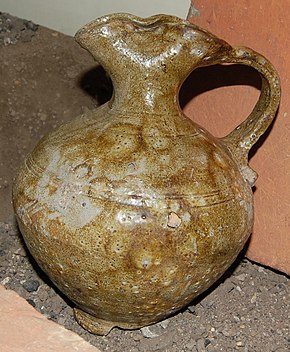Derby Racecourse Roman settlement

A Green Glazed Jug from the Racecourse settlement
|
|
|
Map showing the location of Derby Racecourse Roman settlement within Derbyshire.
|
|
| Location | Derby, Derbyshire |
|---|---|
| Region | East Midlands |
| Coordinates | 52°56′05″N 1°27′49″W / 52.934672°N 1.463546°W |
| Type | Roman fort |
| Part of | Icknield Street |
| History | |
| Founded | 120 |
| Site notes | |
| Website | www |
| Pastscape | |
The Derby Racecourse Roman settlement was the third settlement in Derby or Derventio was a small town in the Roman province of Britannia. It lies 600m east of Derventio fort in Little Chester, on the outskirts of Derby, in the English county of Derbyshire. The Roman road from Derventio to Sawley on the River Trent passes the settlement. It is a scheduled National Monument.
The first Roman fort in the area was built on the opposite bank of the River Derwent at Strutt's Park. It was replaced about AD 80 by a fort at Little Chester, but this only lasted about forty years, then decommissioned. The fort was later re-occupied and re-used for a further twenty five years then unoccupied until the late 3rd century when a stone wall was built around the town. There is evidence of extensive Roman activity in Little Chester. Derby Racecourse Roman settlement site was founded around AD 90. It is considered by English Heritage to be an import example of a fort-vicus. This was a civilian settlement attached to a Roman military fort- in this case Derventio. It is a mark that the Cornovii tribesmen were accepting the Roman way of life and integrating themselves into the Roman economy- i.e. Romanisation.
Pottery kilns have been discovered dating from AD90 to the mid second century when ironworking took place. The jug illustrated was fired at this settlement and is now in Derby Museum. There was also a large cemetery with five stone mausolea.
This part of Britannica was occupied by a tribe known as the Cornovii. In AD 46-47 the Roman Army under the direction of governor Aulius Plautius had probably occupied the lands to the south of the River Trent, so in AD 50 this was the front line. There is a shortage of written documentation about these years so reliance is made on archaeological excavations. Late in 47 the new governor of Britain, Ostorius Scapula, began a campaign against the tribes of modern day Wales, and the Cheshire Gap. During these times Strutt's Park Roman fort, was one of the new forts built along the new supply road from Wroxeter to Rossington.
...
Wikipedia

